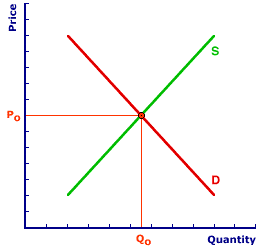
|
|
PART-TIME WORKERS: People who are willing and able to work full-time (over 35 hours per week), but are forced to work less because employers don't need their productive efforts. While part-time workers officially have jobs, and are officially included in the "employed" category when the official unemployment rate is calculated, their labor resources are really only partially unemployed. A person working 20 hours a week, who is willing and able to work 40 hours a week, really should be considered as "half employed."
Visit the GLOSS*arama
|
|


|

|
                           FLEXIBLE PRICES: The proposition that prices adjust in the long run in response to market shortages or surpluses. This condition is most important for long-run macroeconomic activity and long-run aggregate market analysis. In particular, flexible prices are the key reason for the vertical slope of the long-run aggregate supply curve. This proposition is also central to the original classical theory of macroeconomics and to modern variations, including rational expectations, new classical theory, and supply-side economics. Price flexibility ensures that long-run aggregate production is equal to full-employment production. In particular, changes in the price level are met by equal changes in resource prices, especially wages. A higher or lower price level might temporarily lead to an increase or decrease in real production, above or below the full-employment level, but in the long run, resource prices adjust and full-employment production is maintained.| Flexible Prices |  |
To see how this works consider the exhibit to the right. This exhibit illustrates a typical product market, in this case for Wacky Willy Stuffed Amigos. The market is initially in equilibrium, given by the intersection of the demand and supply curves.A shock of the Stuffed Amigos market can serve to illustrate flexible prices, and how price flexibility maintains full employment. - Market Demand Shock: The place to begin is with the demand side of the Stuffed Amigos market. In particular, suppose that the market demand decreases due to a an overall decline in aggregate demand throughout the economy. To illustrate this demand shock, click the [Demand Decrease] button. As might be expected, the equilibrium price of Stuffed Amigos declines and the equilibrium quantity is less.
- Labor Demand Adjusts: With the decrease in the sales of Stuffed Amigos, production also declines. With less production, The Wacky Willy Company needs fewer inputs, including labor. This decrease in labor demand results in a lower wage. The declining wage underlies the movement along the market supply curve corresponding with a decline in production cost and a decrease in the quantity supplied. The microeconomic analysis of Stuffed Amigos exchange need not proceed further. However, in the macroeconomic analysis of aggregate product and resource markets, there is more to this story.
- Labor Supply Reacts: The lower price level of Stuffed Amigos, combined with comparable decreases in the prices for other markets throughout the economy, results in a lower price level. This lower price level increases the real wage of Stuffed Amigos producing labor. These workers are thus inclined to increase their productivity and/or accept a lower wage.
- Back to Market Supply: The adjustment on the supply-side of the labor market reduces the cost of producing Stuffed Amigos. This results in a rightward shift of the market supply curve, which can be illustrated by clicking the [Supply Increase] button. This rightward shift of the market supply curve results in a lower price and a greater quantity. As production increases, employment returns to the original full-employment level.
This macroeconomic adjustment to a decline in market demand is ONLY possible with flexible prices. If prices are not flexible, if the price of Stuffed Amigos does not decline, if the prices other goods does not decline, if the wages paid to Stuffed Amigos producing labor do not adjust, then the Stuffed Amigos market does not return to its original full-employment equilibrium level.

Recommended Citation:FLEXIBLE PRICES, AmosWEB Encyclonomic WEB*pedia, http://www.AmosWEB.com, AmosWEB LLC, 2000-2025. [Accessed: July 18, 2025].
Check Out These Related Terms... | | | | | | |
Or For A Little Background... | | | | | | | | | | | | | |
And For Further Study... | | | | | | | | | | | | | | |
Search Again?
Back to the WEB*pedia
|



|

|
|
Lewis Carroll, the author of Alice in Wonderland, was the pseudonym of Charles Dodgson, an accomplished mathematician and economist.
|

|
|
"A winner is someone who recognizes his God-given talents, works his tail off to develop them into skills, and uses those skills to accomplish his goals. " -- Larry Bird, basketball player
|

|
OSE
Osaka Securities Exchange (Japan)
|

|
|
Tell us what you think about AmosWEB. Like what you see? Have suggestions for improvements? Let us know. Click the User Feedback link.
User Feedback
|


|


